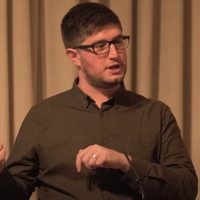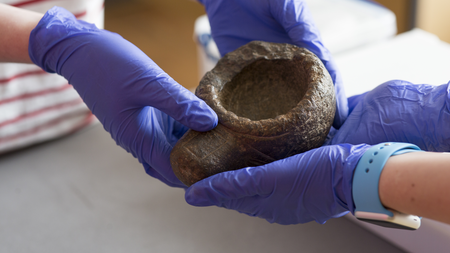
Interdisciplinary Fellow
- About
-
- Email Address
- michael.stratigos1@abdn.ac.uk
- School/Department
- School of Geosciences
Biography
Michael undertook an undergraduate MA in Archaeology here at the University of Aberdeen before attending the University of Southampton for a postgradue MA in Maritime Archaeology. Returning to Aberdeen for PhD research, Michael's research established a baseline for understanding crannogs in north-east Scotland which made the first attempt to systematically map loch drainage to understand this lake-dwelling phenomenon.
This work led to his first post-doctoral appointment (2017-2020) at the Scottish Universities Environmental Research Centre in East Kilbride working on the Living on Water project building high resolution chronologies using radiocarbon wiggle-match dating for crannogs in Loch Tay, Perthshire. Following this 3-year project, Michael was appointed as a post-doctoral research associate (2020-2023) at the Leverhulme Centre for Anthropocene Biodiversity at the University of York. Michael led research here investigating how archaeology might be used to understand biodiversity change through, and importantly how human-environment interactions shape biological conservation in the present.
In July 2023, Michael took up a post as an Interdisciplinary Fellow part of the University of Aberdeen's 2040 Strategy. In this role, he is continuing his research on past human-environment interactions and how that impacts conservation efforts such as Rewilding and other types of environmental restoration.
Interdisciplinary Research and Innovation Symposium 2024
Hosted by the Interdisciplinary Institute, we invite staff and students to join the Interdisciplinary Research and Innovation Symposium on Wednesday 4 September. The event will provide an exciting opportunity to highlight the latest developments in interdisciplinary research and innovation taking case studies from across the University of Aberdeen. To submit an abstract (deadline 16 August) or register to attend visit our event page.
Qualifications
- MA Archaeology2012 - University of Aberdeen
- MA Maritime Archaeology2013 - University of Southampton
- PhD Archaeology2017 - University of Aberdeen
- Research
-
Research Overview
My research sits at the intersection of archaeology and biological conservation. I am interested in how archaeological data and perspectives can be brought to bear on addressing catastrophic declines of biodiversity. With a particular focus on freshwater and coastal environments, my current research examines how human activity is responsible for many or even most habitats and species that we value and protect. This makes decisions about biological conservation as much about past human actions (ie. archaeology) as it is about ecology. A major challenge my research aims to address is bringing that archaeological perspective to the policy and practice of biological conservation.
Research Areas
Accepting PhDs
I am currently accepting PhDs in Archaeology.
Please get in touch if you would like to discuss your research ideas further.

Archaeology
Accepting PhDsPast Research
Michael got his start in research investigating crannogs in north-east Scotland. Crannogs are artificial island dwellings common in Scotland and Ireland and date primarily from the Iron Age (c. 800 BC to AD 400) and the medieval period (AD 400 to AD 1600). Charting historic drainage and the analysis of the history of research of these often enigmatic, but exceptionally rich, archaeological sites, Michael's research has identified over fifty likely crannogs, previously understood as other types of archaeological site or otherwise completely unknown.
This PhD research fed into a 3-year Historic Environment Scotland funded research project that aimed to build high resolution radiocarbon chronologies for Early Iron Age crannogs in Loch Tay, Perthshire. Based at the Scottish Universities Environmental Research Centre, this work developed radiocarbon wiggle-match dates on dendrochronologically linked groups of structural timbers from seven crannogs around Loch Tay dating to the Halstatt plateau period (800-400 cal BC) of the radiocarbon calibration curve.
Collaborations
Michael has ongoing external research collaborations with the RSPB and the Leverhulme Centre for Anthropocene Biodiversity at the University of York.
Funding and Grants
University of Aberdeen Pump-prime Funding
2023
Wild Scotland?: Interdisciplinary perspectives on the challenges and opportunities of Rewilding
British Academy Small Grant
2022
Archaeology and Anthropocene Biodiversity: leveraging the past to protect the future
NEIF Radiocarbon Facility Fund
2020
Chronological Modelling of Settlement Patterns in Iron Age Central Scotland
University of Bradford Research Development Fund
2018-19
Shetland Submerged Landscapes
National Museum of Scotland
2019-20
Torrs Pony Cap Environs Project, Phase II
Royal Archaeological Institute
2018-19
At the Water’s Edge: Early Iron Age settlement patterns in central Scotland
Historic Environment Scotland
2018
Scotland’s Underwater Archaeology Conference
Findlay Harris Dick Prize
2017
Loch of the Clans Crannog Excavation
National Museum of Scotland
2016
Torrs Pony Cap Environs Project
Society of Antiquaries of Scotland
2015
Crannogs in North-east Scotland - Ballater to Banchory
Hunter Archaeological and Historical Trust
2015
Living on the water: a paleoenvironmental analysis of a medieval crannog
Aberdeen Humanities Fund
2015
Living by the Loch: human occupation and landscape history at Loch Kinord, Aberdeenshire
Joan du Platt Taylor Award (Nautical Archaeology Society)
2011
New Approaches in Crannog Archaeology: Investigating Loch Kinord
- Publications
-
Page 1 of 2 Results 1 to 10 of 18
Building Isolation and Connection, tracing monastic use of crannogs in medieval Scotland
Islands, Monasteries and Water. Tubingen University PressChapters in Books, Reports and Conference Proceedings: Chapters (Peer-Reviewed)Between reclamation and restoration: the archaeology, historical ecology and future development of drained wetland landscapes
Journal of Wetland Archaeology, vol. 22, no. 1-2, pp. 1-6Contributions to Journals: Articles- [ONLINE] DOI: https://doi.org/10.1080/14732971.2023.2248706
Areas of Outstanding Nineteenth Century Beauty: Historic landscape characterisation analysis of protected areas in England
People and Nature, vol. 5, no. 1, pp. 198-212Contributions to Journals: ArticlesWhat Wetland are We Protecting and Restoring?: Quantifying the Human Creation of Protected Areas in Scotland
Journal of Wetland Archaeology, vol. 22, no. 1-2, pp. 143-159Contributions to Journals: Articles- [ONLINE] DOI: https://doi.org/10.1080/14732971.2022.2101190
Lake and crannog: A 2500-year palaeoenvironmental record of continuity and change in NE Scotland
Quaternary Science Reviews, vol. 285, 107532Contributions to Journals: ArticlesIron Age construction and Early Medieval reuse of crannogs in Loch Awe, Argyll: new radiocarbon dates and analysis
Proceedings of the Society of Antiquaries of Scotland, vol. 150, pp. 435-449Contributions to Journals: Articles- [ONLINE] DOI: https://doi.org/10.9750/psas.150.1323
- [ONLINE] Link to AM at Archaeology Data Service
- [ONLINE] View publication in Scopus
Island Dwellings at 60° North: New Evidence for Crannogs in Iron Age Shetland
Oxford Journal of Archaeology, vol. 40, no. 3, pp. 286-308Contributions to Journals: ArticlesA Model of Coastal Wetland Palaeogeography and Archaeological Narratives: Loch Spynie, Northern Scotland
Journal of Wetland Archaeology, vol. 20, no. 1-2, pp. 43-58Contributions to Journals: ArticlesBuilding crannogs in the 9th–12th centuries AD in northern Scotland: An old tradition in a new landscape
Seasonal settlement: In the medieval and early modern countryside.. Dixon, P., Theune, C. (eds.). Sidestone Press Academics, pp. 179-189, 10 pagesChapters in Books, Reports and Conference Proceedings: ChaptersEnvironment, Economy and Subsistence: Landscape Reconstruction
Darkness Visible: The Sculptor's Cave, Covesea, from the Bronze Age to the Picts. Society of Antiquaries of Scotland, pp. 215-244, 30 pagesChapters in Books, Reports and Conference Proceedings: Chapters
